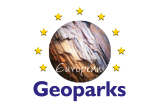Geological heritage of the Bakony–Balaton Geopark
Wandering in Geological Wonderland…
It can be impartially stated that the Bakony–Balaton Geopark area internationally has an outstandingly rich geological past and geological build-up. It is located in the western part of Hungary with its area covering more than 3,200 square kms. Most of its territory can be found North of the Lake Balaton, which is the largest shallow-water lake in Central Europe, and it also encompasses a large part of the Bakony Mountains.
This description can give you no more than a taste of the most significant values of the geological and cultural-historic heritage; however, we are hopeful that this selection encourages the Reader to take a closer look at them as a Visitor. Different publications and nature trails help us in the course of our “field expeditions”. They provide complete or partial information about the geological values.
Starting our imaginary excursion at the eastern end of Lake Balaton (which is a young one from a geological point of view, dating back 15,000 years), the steep walls at Balatonkenese can be well seen from a great distance. They expose the sandy-clayey deposits of the one-time Lake Pannonian, and on the top of the walls our highly protected botanical value, the Crambe tataria can be found.
One of the characteristic building materials of the Balaton Uplands, the red sandstone of Permian period can be observed at several sites. It is a flood-plain deposit. It is worth getting acquainted with this rock exposed in a quarry—which underwent landscape rehabilitation—at the shores of the Lake Köcsi, near Balatonalmádi.
The oldest, the most well-known and world-famous geological key section in the Balaton Uplands can be found in the northern outskirts of Felsőörs, on the side of the Forrás Hill. The key section, in which a geological trail was developed, exposes the 242–238-million-year-old Middle Triassic succession ranging from the Middle Anisian up to the Middle Ladinian.
In the Lóczy Cave, in the outskirts of Balatonfüred, we can study solution forms derived from upwelling thermal waters.
Since 2003 the Tihany Peninsula, which is famous for the ancient Benedictine Abbey, has been the holder of the prestigious award, the European Diploma. The crucial factor considered in awarding this acknowledgement was the rich geological, volcanological and geomorphological heritage, which determines the landscape of the whole peninsula.
The first characteristic period of volcanism in the area started 8 million years ago, in the late Miocene. There are several localities on the peninsula where volcanic formations can be well studied; for example, while examining the spectacular rock faces of the Monks’ cells, we can imagine the series of explosions rapidly following each other, and the frightful rumbling noise of pyroclastic flows (fast-moving currents of gas and rock travelling away from the site of the explosion).
If we happen to go to the Pécsely Basin, after wandering over its intimate villages and vineyards, it is worth visiting the peculiar karrenfeld or limestone pavement of the Kő Hill at Kisdörgicse (a karst landform consisting of a flat, incised rock surface of exposed limestone).
At the margins of the Káli Basin, “seas of stones” can be found around a group of drowsy, little villages. The rock-forming, originally easily-erodable Pannonian sediments were cemented by solutions rich in silica. Contrary to the sandy-gravelly deposits, these rock bodies are resistant to erosional processes, and were sculptured by selective erosion; this is how these unique landscape forms developed. The Hegyestű Geological Visitor Site is situated at the eastern margin of the basin, close to the village of Monoszló. Visitors may admire not only the columnar basalt wall of the characteristic hill, and the stunning view from the hilltop, but in the Transdanubian Regional Stone Park they can get acquainted with the most characteristic rocks of the wider area. The volcanic remnant hills in the Tapolca Basin (Badacsony, Szent György Hill and Csobánc Hill, etc.) can be regarded as the most characteristic landscape elements of the Geopark; this area is a treasury of different volcanological landforms and sights.
In several places the so-called maar volcanism was followed by a relatively “calmer” volcanic activity, which produced lava fountains and scoria cones, nevertheless for most of the time it was characterised by lava flows. Later, after the elevation of the area had commenced the uplifting and climatic changes resulted in the erosion of loose sediments from areas uncovered by volcanic formations. The characteristic landscape of the Tapolca Basin, dissected by the “calmed-down” volcanoes, has developed due to the landscape forming processes of water and wind erosion. We should not forget that the “land of the basalt organs” is also rich in botanical values and cultural-historical relics. The latter include castle ruins, old press houses and lonely chapels. The main goal of the Kamon-kő Nature Trail—starting from the church of Szigliget —is to introduce the visitors to these values and to the heritage related to the thousand-year-old viticulture.
Most of the visitors to Lake Balaton have not the slightest idea that there is a more than 9 km-long tortuous cave system under the streets and houses of the town of Tapolca that can be reached with a ten-minute drive from the lakeshore. To be more precise, this portion of a cave system has been explored so far... Among the 14 caves registered in the inner-city area, the longest one is the Lake Cave of Tapolca (which is almost 3.3 km long). Visiting its 270 m-long entrance section and making the boat trip in it provides an exceptional experience.
The Csodabogyós Cave was formed in the Upper Triassic Ederics Limestone, which can be observed only in small patches in the Keszthely Mountains. A part of the cave—which is rich in stalactites and stalagmites—is opened to brave candidates for adventure tours in “caving overalls” (information/registration: www.csodabogyos.hu).
Slightly North of it the Sümeg Castle stands on a lonely limestone cone and recalls the spirit of ancient adventure stories. Close to it there are several Nature Conservation Areas of national importance in the area of the Geopark, which were taken under protection due to their special geological values. One of them, the Úrkút Palaeokarst Nature Conservation Area in the Southern Bakony Mountains is characterised by unique palaeokarstic phenomena exhibited to an extraordinary extent in respect to Hungary (visitors can take a walk along an excellent nature trail).
Also in the Southern Bakony, in the area of the one-time royal huntingfield, a cave (Szentgáli-kőlik) is opened to the public. It offers adventures for those who like creeping and crawling in caves, and for those who are interested in archaeological finds, since in this cave visitors can get acquainted with the history of urns dated to the Bronze Age (information and registration: www.szentgali-kolik.hu).
The exhibition of the Bakony Natural History Museum in Zirc—which is regarded as the “capital” of the Bakony Mountains—emphasises the interpretation of our geological heritage. It is worth visiting this exhibition, where, besides the minerals of the Carpathian Basin, mammoth remains recently found in the vicinity of the Lake Balaton, can also be admired. The latter are displayed at an exhibition (having an expressive name): “Giants of the Ice Age”.
Talking about creatures of ancient times, the vertebrate finds (including dinosaur remains) of the Late Cretaceous period (85–90 million years ago) and found in the High Bakony area, may be considered as the greatest palaeontological sensation of the last few years. Its significance is due not only to the fact that it is the only locality that yielded dinosaur remains in Hungary, but also to the fact that the number of armoured dinosaur remains found here exceeds the number of such remains derived from other European localities. Although the remains are kept by the Hungarian Natural History Museum (Budapest), plans are being outlined to establish a “dino park” in the vicinity of the locality, with the co-operation of several organisations.
There are carbonate rocks on the surface in a significant part of the Geopark, and the area of the Tés Plateau (Eastern Bakony) and its surroundings are especially rich in karst phenomena. Besides the caves and ponors, the Roman Baths, the wonderful example of the coexistence between nature and man must be mentioned (for example the old windmills in the fields of Tés).
Várpalota is a town within the Geopark; it possesses a peculiar geological heritage in the inner city: the sedimentary sequence (see at the bottom of the page) of the Várpalota Sandpit Nature Conservation Area that demonstrates the extraordinary sedimentary features and the rich mollusc fauna of the Miocene seashore as an opened geological coursebook (information/ registration: www.homokbanya.eu).
Dear Reader (and prospective Visitor)! We hope we have aroused your interest and we can welcome you in this Geological Wonderland. We wish you a pleasant journey in time!









